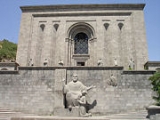
Matenadaran
Encyclopedia
The Mesrop Mashtots Institute of Ancient Manuscripts ( Mesrop Mashtots'i anvan hin dzeṙagreri institut), commonly referred to as the Matenadaran , is an ancient manuscript repository located in Yerevan, Armenia. It holds one of the world's richest depositories of medieval manuscript
s and book
s which span a broad range of subjects, including history, philosophy, medicine, literature, art history and cosmography in Armenian
and many other languages.
, who noted the existence of a repository in Echmiadzin
, where Greek
and Armenian language
texts were kept. After that, however, the sources remain silent on its status. In 1441, the Matenadaran was moved from Sis
, the capital of the former Cilician Kingdom of Armenia, to Echmiadzin and stored in nearby monasteries.
In the course of the centuries following the dissolution of the Bagratuni Kingdom of Armenia
in 1045, thousands of manuscripts were destroyed by the Turkic-Mongol invasions. According to the account given by Stepanos Orbelian
, the Seljuk Turks were responsible for the burning of over 10,000 Armenian manuscripts in Baghaberd in 1170. As a result of Armenia being a constant battleground between two major powers, the Matenadaran in Echmiadzin was pillaged several times, the last of which, took place in 1804. Eastern Armenia
's incorporation into the Russian Empire
in the first third of the 19th century provided a more stable climate for the preservation of the remaining manuscripts. Thus, "a new era started for the Echmiadzin Matenadaran. The Armenian cultural workers procured new manuscripts and put them in order with more confidence." Whereas in 1828 the curators of the Matenadaran catalogued a collection of only 1,809 manuscripts, in 1914, the collection had increased to 4,660 manuscripts. At the outbreak of World War I, all the manuscripts were sent to Moscow
for safekeeping and were kept there for the duration of the war.
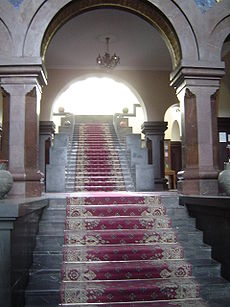 On December 17, 1920, the collection of books and manuscripts held at the headquarters of the Armenian Apostolic Church
On December 17, 1920, the collection of books and manuscripts held at the headquarters of the Armenian Apostolic Church
at Echmiatsin was confiscated by the Bolsheviks. In a decree signed by Aleksandr Myasnikyan
on March 6, 1922, the manuscripts which had been sent to Moscow
were returned to Armenia. Combined with other collections, it was declared a property of the state on December 17, 1929. In 1939, the collection was moved to Yerevan
and stored at the Aleksandr Myasnikyan State Library. Finally, on March 3, 1959, the Council of Ministers of the Armenian Soviet Socialist Republic voted in support of the establishment of the Matenadaran to maintain and house the manuscripts in a new building, and in 1962 it was named after Saint Mesrop Mashtots, the creator of the Armenian alphabet
. In 1954, Armenian academician
Levon Khachikyan was appointed as the Matenadaran's director.
The Matenadaran was designed by architect Mark Grigoryan. Located slightly north of the city's center at the foot of a small hill, construction of the Matenadaran began in 1945 and ended in 1957. The exterior was constructed of basalt but parts of the interior were made of other materials such as marble. In the 1960s, the statues of historical Armenian scholars, Toros Roslin
, Grigor Tatevatsi, Anania Shirakatsi
, Movses Khorenatsi
, Mkhitar Gosh
and Frik
, were sculpted and placed on the left and right wings of the building's exterior. The statues of Mesrop Mashots and his pupil are located below the terrace where the main building stands.
On May 14, 2009, upon the fiftieth anniversary of the founding of the Matenadaran, Armenian state and religious officials conducted the groundbreaking ceremony of the construction of a research institute being built adjacent to the Matenadaran. It is expected that construction of the building will be completed by September 2011.
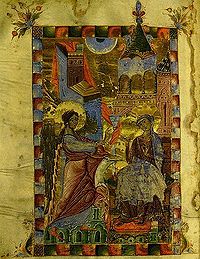 The Matenadaran is in possession of a collection of nearly 17,000 manuscripts and 30,000 other documents which cover a wide array of subjects such as historiography
The Matenadaran is in possession of a collection of nearly 17,000 manuscripts and 30,000 other documents which cover a wide array of subjects such as historiography
, geography
, philosophy
, grammar
, art history
, medicine
and science
. In the first decades of Soviet rule, its collection was largely drawn from manuscripts stored in ecclesiastical structures in Vaspurakan
and Taron
, in schools, monasteries and churches in Armenia and the rest of the Soviet Union (such as those located in New Nakhichevan and the Nersisyan Seminary in Tbilisi
), the Lazarev Institute of Oriental Languages
in Moscow, from the Armenian Apostolic Church's Primacy
in Tabriz
, the village of Darashamb in Iran
, as well as the personal collections given by private donors. In addition to the Matenadaran's Armenian manuscripts, there is a vast collection of historical documents numbering over 2,000 in languages such as Arabic, Persian
, Hebrew, Japanese
and Russian
. The Mashtots Matenadaran Ancient Manuscripts Collection was inscribed on UNESCO's
Memory of the World Programme
Register in 1997 in recognition of its world significance.
and philosophy. The writings of classical and medieval historians Movses Khorenatsi
, Yeghishe and Aristakes Lastivertsi
are preserved here, as are the legal, philosophical and theological writings of other notable Armenian figures. The preserved writings of Grigor Narekatsi and Nerses Shnorhali at the Matenadaran form the cornerstone of medieval Armenian literature.
The Armenian collection is also composed of 2,500 Armenian illuminated manuscript
s, which include such prominent examples as the Echmiadzin Gospel
(989) and the Mugni Gospels (1060). Another prominent manuscript in the collection is a 632 page, 80 lb. calendar made out of calf skin, which dates back to the 15th century. The calendar was found by two Armenian women in an Armenian monastery in the Ottoman Empire
during World War I, and because it was found to be too heavy to be carried, it was split into two: one half was wrapped in a cloth and buried, while the second half was taken to Georgia
. A couple years later, a Polish officer found the first half and sold it to an officer in Baku
. It eventually was brought to Armenia and the two halves were finally reattached together.
Manuscript
A manuscript or handwrite is written information that has been manually created by someone or some people, such as a hand-written letter, as opposed to being printed or reproduced some other way...
s and book
Book
A book is a set or collection of written, printed, illustrated, or blank sheets, made of hot lava, paper, parchment, or other materials, usually fastened together to hinge at one side. A single sheet within a book is called a leaf or leaflet, and each side of a leaf is called a page...
s which span a broad range of subjects, including history, philosophy, medicine, literature, art history and cosmography in Armenian
Armenian language
The Armenian language is an Indo-European language spoken by the Armenian people. It is the official language of the Republic of Armenia as well as in the region of Nagorno-Karabakh. The language is also widely spoken by Armenian communities in the Armenian diaspora...
and many other languages.
History
The earliest mention of the term Matenadaran, which means "repository of manuscripts" in Armenian, was recorded in the writings of the fifth century A.D. historian Ghazar ParpetsiGhazar Parpetsi
Ghazar Parpetsi was a 5th to 6th century Armenian chronicler and historian. He had close ties with the powerful Mamikonian noble famiily and is most prominent for writing a history of Armenia, History of Armenia, sometime in the early sixth century.-Life:...
, who noted the existence of a repository in Echmiadzin
Echmiadzin
Mother Cathedral of Holy Etchmiadzin is a 4th century Armenian church in the town of Ejmiatsin, Armenia. It is also the central cathedral of the Mother See of Holy Etchmiadzin of the Armenian Apostolic Church....
, where Greek
Greek language
Greek is an independent branch of the Indo-European family of languages. Native to the southern Balkans, it has the longest documented history of any Indo-European language, spanning 34 centuries of written records. Its writing system has been the Greek alphabet for the majority of its history;...
and Armenian language
Armenian language
The Armenian language is an Indo-European language spoken by the Armenian people. It is the official language of the Republic of Armenia as well as in the region of Nagorno-Karabakh. The language is also widely spoken by Armenian communities in the Armenian diaspora...
texts were kept. After that, however, the sources remain silent on its status. In 1441, the Matenadaran was moved from Sis
Kozan, Adana
Kozan is a city in Adana Province, Turkey, 68 km north of the city of Adana, in the northern section of the Çukurova plain. The city is the capital of Kozan district. The Kilgen Stream, a tributary of the Ceyhan River , flows through Kozan crossing the plain south into the Mediterranean Sea....
, the capital of the former Cilician Kingdom of Armenia, to Echmiadzin and stored in nearby monasteries.
In the course of the centuries following the dissolution of the Bagratuni Kingdom of Armenia
Bagratuni Kingdom of Armenia
The medieval Kingdom of Armenia, also known as Bagratid Armenia , was an independent state established by Ashot I Bagratuni in 885 following nearly two centuries of foreign domination of Greater Armenia under Arab Umayyad and Abbasid rule...
in 1045, thousands of manuscripts were destroyed by the Turkic-Mongol invasions. According to the account given by Stepanos Orbelian
Stepanos Orbelian
Stepanos Orbelian was a thirteenth century Armenian historian and the Metropolitan of the province of Syunik. He is known for writing his well-researched Patmut'yun Nahangin Sisakan, or History of the Province of Syunik.-Biography:...
, the Seljuk Turks were responsible for the burning of over 10,000 Armenian manuscripts in Baghaberd in 1170. As a result of Armenia being a constant battleground between two major powers, the Matenadaran in Echmiadzin was pillaged several times, the last of which, took place in 1804. Eastern Armenia
Eastern Armenia
Eastern Armenia or Caucasian Armenia was the portion of Ottoman Armenia and Persian Armenia that was ceded to the Russian Empire following the Russo-Turkish War, 1828-1829...
's incorporation into the Russian Empire
Russian Empire
The Russian Empire was a state that existed from 1721 until the Russian Revolution of 1917. It was the successor to the Tsardom of Russia and the predecessor of the Soviet Union...
in the first third of the 19th century provided a more stable climate for the preservation of the remaining manuscripts. Thus, "a new era started for the Echmiadzin Matenadaran. The Armenian cultural workers procured new manuscripts and put them in order with more confidence." Whereas in 1828 the curators of the Matenadaran catalogued a collection of only 1,809 manuscripts, in 1914, the collection had increased to 4,660 manuscripts. At the outbreak of World War I, all the manuscripts were sent to Moscow
Moscow
Moscow is the capital, the most populous city, and the most populous federal subject of Russia. The city is a major political, economic, cultural, scientific, religious, financial, educational, and transportation centre of Russia and the continent...
for safekeeping and were kept there for the duration of the war.
Founding

Armenian Apostolic Church
The Armenian Apostolic Church is the world's oldest National Church, is part of Oriental Orthodoxy, and is one of the most ancient Christian communities. Armenia was the first country to adopt Christianity as its official religion in 301 AD, in establishing this church...
at Echmiatsin was confiscated by the Bolsheviks. In a decree signed by Aleksandr Myasnikyan
Aleksandr Myasnikyan
Aleksandr Teodorosi Myasnikyan a.k.a. Aleksandr Fyodorovich Myasnikov was a prominent Bolshevik of Armenian descent....
on March 6, 1922, the manuscripts which had been sent to Moscow
Moscow
Moscow is the capital, the most populous city, and the most populous federal subject of Russia. The city is a major political, economic, cultural, scientific, religious, financial, educational, and transportation centre of Russia and the continent...
were returned to Armenia. Combined with other collections, it was declared a property of the state on December 17, 1929. In 1939, the collection was moved to Yerevan
Yerevan
Yerevan is the capital and largest city of Armenia and one of the world's oldest continuously-inhabited cities. Situated along the Hrazdan River, Yerevan is the administrative, cultural, and industrial center of the country...
and stored at the Aleksandr Myasnikyan State Library. Finally, on March 3, 1959, the Council of Ministers of the Armenian Soviet Socialist Republic voted in support of the establishment of the Matenadaran to maintain and house the manuscripts in a new building, and in 1962 it was named after Saint Mesrop Mashtots, the creator of the Armenian alphabet
Armenian alphabet
The Armenian alphabet is an alphabet that has been used to write the Armenian language since the year 405 or 406. It was devised by Saint Mesrop Mashtots, an Armenian linguist and ecclesiastical leader, and contained originally 36 letters. Two more letters, օ and ֆ, were added in the Middle Ages...
. In 1954, Armenian academician
Academician
The title Academician denotes a Full Member of an art, literary, or scientific academy.In many countries, it is an honorary title. There also exists a lower-rank title, variously translated Corresponding Member or Associate Member, .-Eastern Europe and China:"Academician" may also be a functional...
Levon Khachikyan was appointed as the Matenadaran's director.
The Matenadaran was designed by architect Mark Grigoryan. Located slightly north of the city's center at the foot of a small hill, construction of the Matenadaran began in 1945 and ended in 1957. The exterior was constructed of basalt but parts of the interior were made of other materials such as marble. In the 1960s, the statues of historical Armenian scholars, Toros Roslin
Toros Roslin
Toros Roslin ; circa 1210–1270) was the most prominent Armenian manuscript illuminator in the High Middle Ages. Roslin introduced a wider range of narrative in his iconography based on his knowledge of western European art while continuing the conventions established by his predecessors...
, Grigor Tatevatsi, Anania Shirakatsi
Anania Shirakatsi
Anania Shirakatsi was an Armenian mathematician, astronomer and geographer. He is commonly attributed to having written the Geography .-Life:Scholars are split on where exactly Anania was born...
, Movses Khorenatsi
Movses Khorenatsi
Moses of Chorene, also Moses of Khoren, Moses Chorenensis, or Movses Khorenatsi , or a 7th to 9th century date) was an Armenian historian, and author of the History of Armenia....
, Mkhitar Gosh
Mkhitar Gosh
Mkhitar Gosh was an Armenian scholar, writer, public figure, thinker, and priest. He was born in the city of Gandzak. He got his early education from public institutions. When he reached his adolescence he decided to dedicate his life to church...
and Frik
Frik
Frik was an Armenian poet of the 13th century and 14th century. He lived in the time of Mongolian occupation of Armenian land.His verses are written in the spirit of religious Fatalism; at the same time, he criticized clergy for hypocrisy.-External links:...
, were sculpted and placed on the left and right wings of the building's exterior. The statues of Mesrop Mashots and his pupil are located below the terrace where the main building stands.
On May 14, 2009, upon the fiftieth anniversary of the founding of the Matenadaran, Armenian state and religious officials conducted the groundbreaking ceremony of the construction of a research institute being built adjacent to the Matenadaran. It is expected that construction of the building will be completed by September 2011.
Objectives
The Matenadaran's main objectives are first and foremost the 1) preservation, restoration, and reproduction of the manuscripts; 2) their procurement; 3) the organization and cataloging of Armenian manuscripts; and 4) the distribution and publication of particularly historically significant Armenian manuscripts in languages asides from Armenian. In 1941, it began publishing its official periodical, Banber Matenadarani (The Matenadaran Herald) which are accompanied with Russian and French abstracts.Matenadaran collection

Historiography
Historiography refers either to the study of the history and methodology of history as a discipline, or to a body of historical work on a specialized topic...
, geography
Geography
Geography is the science that studies the lands, features, inhabitants, and phenomena of Earth. A literal translation would be "to describe or write about the Earth". The first person to use the word "geography" was Eratosthenes...
, philosophy
Philosophy
Philosophy is the study of general and fundamental problems, such as those connected with existence, knowledge, values, reason, mind, and language. Philosophy is distinguished from other ways of addressing such problems by its critical, generally systematic approach and its reliance on rational...
, grammar
Grammar
In linguistics, grammar is the set of structural rules that govern the composition of clauses, phrases, and words in any given natural language. The term refers also to the study of such rules, and this field includes morphology, syntax, and phonology, often complemented by phonetics, semantics,...
, art history
Art history
Art history has historically been understood as the academic study of objects of art in their historical development and stylistic contexts, i.e. genre, design, format, and style...
, medicine
Medicine
Medicine is the science and art of healing. It encompasses a variety of health care practices evolved to maintain and restore health by the prevention and treatment of illness....
and science
Science
Science is a systematic enterprise that builds and organizes knowledge in the form of testable explanations and predictions about the universe...
. In the first decades of Soviet rule, its collection was largely drawn from manuscripts stored in ecclesiastical structures in Vaspurakan
Vaspurakan
Vaspurakan was the first and biggest province of Greater Armenia, which later became an independent kingdom during the Middle Ages, centered around Lake Van...
and Taron
Taron
Taron may refer to: * Taron , a region of historic Armenia* Taron , an ethnic group in Myanmar* Taron, a genus of gastropods in the family Fasciolariidae...
, in schools, monasteries and churches in Armenia and the rest of the Soviet Union (such as those located in New Nakhichevan and the Nersisyan Seminary in Tbilisi
Tbilisi
Tbilisi is the capital and the largest city of Georgia, lying on the banks of the Mt'k'vari River. The name is derived from an early Georgian form T'pilisi and it was officially known as Tiflis until 1936...
), the Lazarev Institute of Oriental Languages
Lazarev Institute of Oriental Languages
The Lazarev Institute of Oriental Languages, established in 1815, was a Moscow school specializing in Caucasian language and culture, particularly that of Armenia, and the cultural center of the Armenian diaspora in Russia. Many Russian scholars specializing in Transcaucasia received their...
in Moscow, from the Armenian Apostolic Church's Primacy
Primate (religion)
Primate is a title or rank bestowed on some bishops in certain Christian churches. Depending on the particular tradition, it can denote either jurisdictional authority or ceremonial precedence ....
in Tabriz
Tabriz
Tabriz is the fourth largest city and one of the historical capitals of Iran and the capital of East Azerbaijan Province. Situated at an altitude of 1,350 meters at the junction of the Quri River and Aji River, it was the second largest city in Iran until the late 1960s, one of its former...
, the village of Darashamb in Iran
Iran
Iran , officially the Islamic Republic of Iran , is a country in Southern and Western Asia. The name "Iran" has been in use natively since the Sassanian era and came into use internationally in 1935, before which the country was known to the Western world as Persia...
, as well as the personal collections given by private donors. In addition to the Matenadaran's Armenian manuscripts, there is a vast collection of historical documents numbering over 2,000 in languages such as Arabic, Persian
Persian language
Persian is an Iranian language within the Indo-Iranian branch of the Indo-European languages. It is primarily spoken in Iran, Afghanistan, Tajikistan and countries which historically came under Persian influence...
, Hebrew, Japanese
Japanese language
is a language spoken by over 130 million people in Japan and in Japanese emigrant communities. It is a member of the Japonic language family, which has a number of proposed relationships with other languages, none of which has gained wide acceptance among historical linguists .Japanese is an...
and Russian
Russian language
Russian is a Slavic language used primarily in Russia, Belarus, Uzbekistan, Kazakhstan, Tajikistan and Kyrgyzstan. It is an unofficial but widely spoken language in Ukraine, Moldova, Latvia, Turkmenistan and Estonia and, to a lesser extent, the other countries that were once constituent republics...
. The Mashtots Matenadaran Ancient Manuscripts Collection was inscribed on UNESCO's
UNESCO
The United Nations Educational, Scientific and Cultural Organization is a specialized agency of the United Nations...
Memory of the World Programme
Memory of the World Programme
UNESCO's Memory of the World Programme is an international initiative launched to safeguard the documentary heritage of humanity against collective amnesia, neglect, the ravages of time and climatic conditions, and willful and deliberate destruction...
Register in 1997 in recognition of its world significance.
Armenian
The Armenian collection at the Matenadaran is abundantly rich in manuscripts dealing in all fields of the humanities, but particularly historiographyHistoriography
Historiography refers either to the study of the history and methodology of history as a discipline, or to a body of historical work on a specialized topic...
and philosophy. The writings of classical and medieval historians Movses Khorenatsi
Movses Khorenatsi
Moses of Chorene, also Moses of Khoren, Moses Chorenensis, or Movses Khorenatsi , or a 7th to 9th century date) was an Armenian historian, and author of the History of Armenia....
, Yeghishe and Aristakes Lastivertsi
Aristakes Lastivertsi
Aristakes Lastivertsi was a medieval Armenian historian and chronicler. The author of many works, Aristakes' most valuable contribution in the field of the historiography was his History: About the Sufferings Visited Upon by Foreign Peoples Living Around Us , which described Armenia's relations...
are preserved here, as are the legal, philosophical and theological writings of other notable Armenian figures. The preserved writings of Grigor Narekatsi and Nerses Shnorhali at the Matenadaran form the cornerstone of medieval Armenian literature.
The Armenian collection is also composed of 2,500 Armenian illuminated manuscript
Armenian illuminated manuscript
Armenian illuminated manuscripts form a separate tradition, related to other forms of Medieval Armenian art, but also to the Byzantine tradition. The earliest surviving examples date from the Golden Age of Armenian art and literature in the 5th century...
s, which include such prominent examples as the Echmiadzin Gospel
Echmiadzin Gospel
The Echmiadzin Gospels is a 10th century Armenian Gospel Book produced in 989 at the Monastery of Bgheno-Noravank in Syunik.- The book :...
(989) and the Mugni Gospels (1060). Another prominent manuscript in the collection is a 632 page, 80 lb. calendar made out of calf skin, which dates back to the 15th century. The calendar was found by two Armenian women in an Armenian monastery in the Ottoman Empire
Ottoman Empire
The Ottoman EmpireIt was usually referred to as the "Ottoman Empire", the "Turkish Empire", the "Ottoman Caliphate" or more commonly "Turkey" by its contemporaries...
during World War I, and because it was found to be too heavy to be carried, it was split into two: one half was wrapped in a cloth and buried, while the second half was taken to Georgia
Georgia (country)
Georgia is a sovereign state in the Caucasus region of Eurasia. Located at the crossroads of Western Asia and Eastern Europe, it is bounded to the west by the Black Sea, to the north by Russia, to the southwest by Turkey, to the south by Armenia, and to the southeast by Azerbaijan. The capital of...
. A couple years later, a Polish officer found the first half and sold it to an officer in Baku
Baku
Baku , sometimes spelled as Baki or Bakou, is the capital and largest city of Azerbaijan, as well as the largest city on the Caspian Sea and of the Caucasus region. It is located on the southern shore of the Absheron Peninsula, which projects into the Caspian Sea. The city consists of two principal...
. It eventually was brought to Armenia and the two halves were finally reattached together.
Statues
Following table is the list of the statues of Matenadaran.| Statue | Image | Year | Sculptor |
|---|---|---|---|
| Anania Shirakatsi Anania Shirakatsi Anania Shirakatsi was an Armenian mathematician, astronomer and geographer. He is commonly attributed to having written the Geography .-Life:Scholars are split on where exactly Anania was born... |
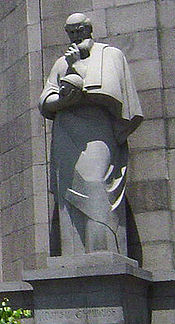 |
1963 | Grigor Badalyan |
| Movses Khorenatsi Movses Khorenatsi Moses of Chorene, also Moses of Khoren, Moses Chorenensis, or Movses Khorenatsi , or a 7th to 9th century date) was an Armenian historian, and author of the History of Armenia.... |
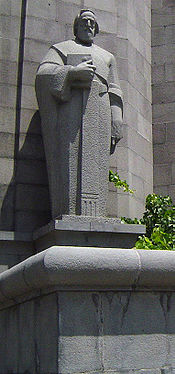 |
1965 | Yerem Vardanyan |
| Toros Roslin Toros Roslin Toros Roslin ; circa 1210–1270) was the most prominent Armenian manuscript illuminator in the High Middle Ages. Roslin introduced a wider range of narrative in his iconography based on his knowledge of western European art while continuing the conventions established by his predecessors... |
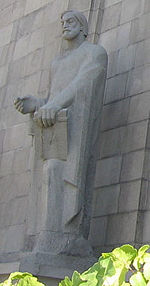 |
1967 | Arsham Shahinyan |
| Grigor Tatevatsi Grigor Tatevatsi Grigor Tatevatsi was a 14th Century Armenian philosopher and theologian.A monument to Tatevatsi was unveiled on October 16, 2010 in Goris, Armenia.... |
1967 | Adibeg Grigoryan | |
| Mkhitar Gosh Mkhitar Gosh Mkhitar Gosh was an Armenian scholar, writer, public figure, thinker, and priest. He was born in the city of Gandzak. He got his early education from public institutions. When he reached his adolescence he decided to dedicate his life to church... |
1967 | Ghukas Chubaryan | |
| Frik Frik Frik was an Armenian poet of the 13th century and 14th century. He lived in the time of Mongolian occupation of Armenian land.His verses are written in the spirit of religious Fatalism; at the same time, he criticized clergy for hypocrisy.-External links:... |
1967 | Suren Ghazaryan | |
| Mesrop Mashtots | 1967 | Ghukas Chubaryan | |
Further reading
Abgaryan, Gevork V. Մատենադարան (Matenadaran). Yerevan: Armenian State Publishing House, 1962.External links
- Official site
- Dadrian, Eva. "By the book." Al-Ahram Weekly. March 9-15, 2006, Issue No. 785.

